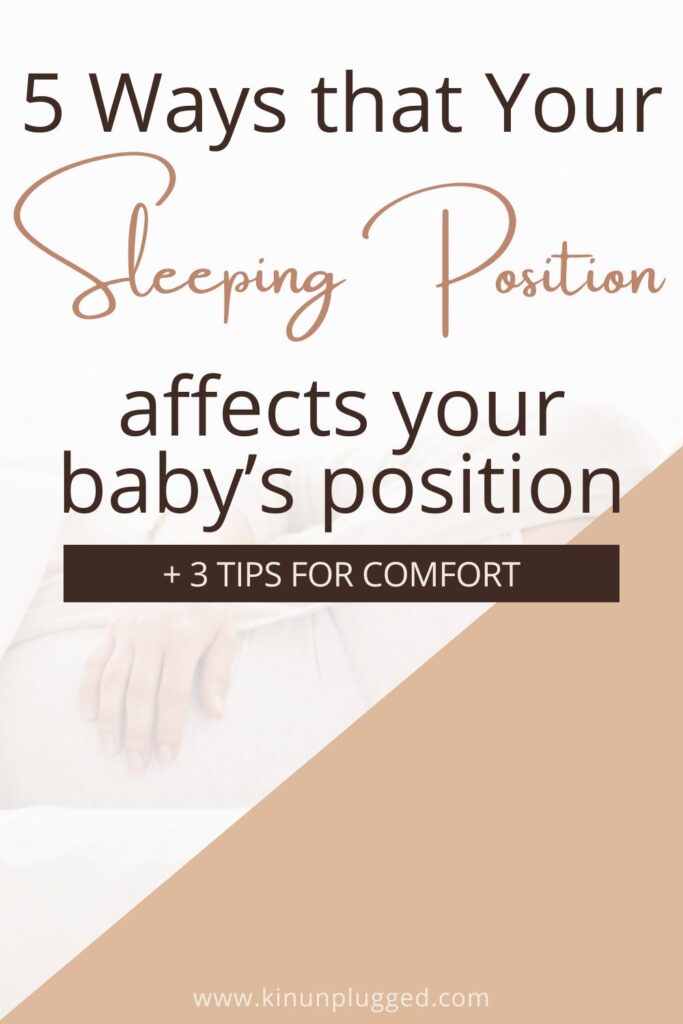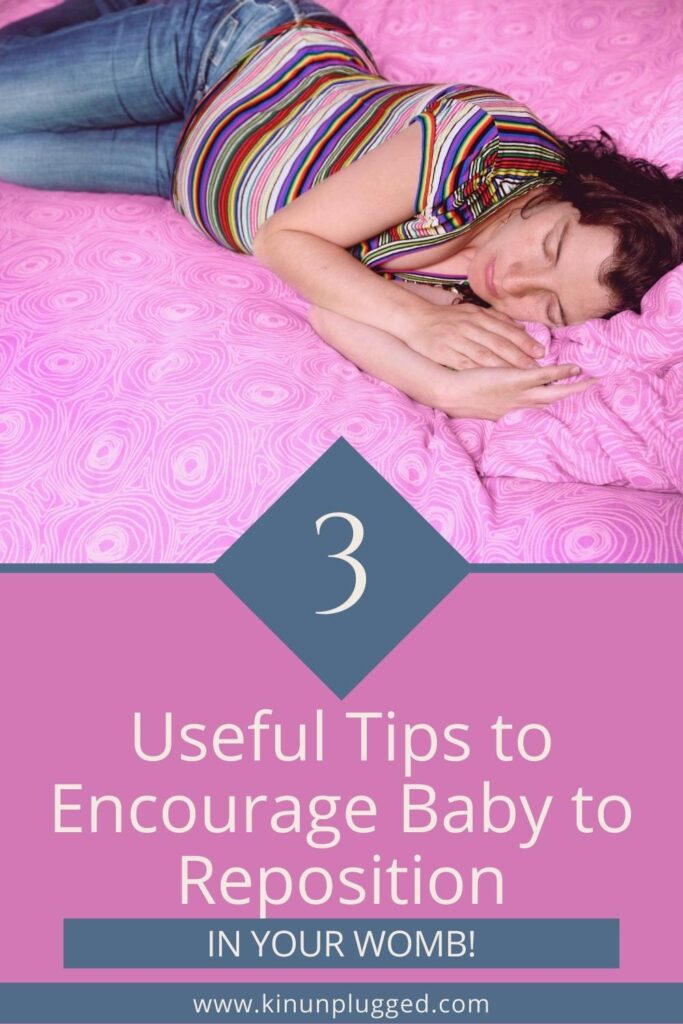Sleep positions in pregnancy only get trickier as you get farther along in your pregnancy. If you’re wondering what options are available to you, keep reading.
In this article, I’ll be sharing the optimal sleeping position for pregnant women that works for the entire duration of your pregnancy.

Can sleep position affect a baby in the womb?
Yes, sleep positions in pregnancy can affect a baby in the womb. During pregnancy, the way you sleep can influence both your comfort and your baby’s well-being. It’s generally recommended that pregnant women sleep on their side, specifically the left side, as this position improves blood flow to the baby and helps reduce swelling.
Sleeping on your back, especially in the later stages of pregnancy, can cause the weight of the uterus to press on major blood vessels. That might decrease circulation to both you and your baby. It might be challenging to stay in one position all night but using a pregnancy sleep pillow to support your body can make side sleeping more comfortable.
So if you find yourself tossing and turning, don’t stress too much. Just try to spend the majority of your rest time on your side. It’s all about finding a balance that works for you and keeps you both cozy and safe.
Wrong sleep positions during pregnancy
During pregnancy, certain sleep positions can be more beneficial than others, while some might be less ideal.
As mentioned above, sleeping on your back, especially in the later stages of pregnancy, can be considered one of the wrong sleep positions in pregnancy.
Another position to avoid is sleeping on your stomach. As your belly grows, this position becomes uncomfortable and impractical and it can put unnecessary pressure on your baby.
As above, the best position to aim for is sleeping on your left side.
Focusing on the right sleep positions in pregnancy can make a big difference for both you and your baby!
RELATED: Some thoughts on sleep
What if I accidentally sleep on my back while pregnant?
If you accidentally sleep on your back while pregnant, don’t worry. It happens! The key is to try to spend most of your sleep time in positions that are safer and more comfortable for you and your baby.
One way to help maintain good sleep positions in pregnancy is by using a pregnancy sleep pillow. These specially designed pillows provide support and help you stay on your side throughout the night. They come in various shapes, like the popular U-shaped or C-shaped designs, which cradle your body and make side sleeping much more comfortable.
If you find yourself waking up on your back occasionally, just gently shift back to your side. It’s all about making small adjustments to ensure both you and your baby are comfortable and healthy.
The most important thing is that you’re getting enough rest. Using tools like a pregnancy sleep pillow can make maintaining the best sleep positions in pregnancy easier and more comfortable.
5 Comfortable sleep positions in pregnancy

Finding comfortable sleep positions in pregnancy can be a bit challenging as your body changes but it’s definitely possible with a few tips and tricks.
1. Side sleeping
To make this position more comfortable,
- use a pregnancy sleep pillow
- tuck a pillow between your knees. This can help align your hips and reduce lower back pain.
2. Propped-up sleeping
If you’re experiencing heartburn or shortness of breath, sleeping slightly propped up can be a comfortable option.
- use extra pillows or a wedge pillow. Elevating your upper body can help ease discomfort from heartburn and make breathing easier.
3. Combination sleeping
Sometimes, a combination of positions can be the most comfortable.
- switch sides occasionally. It’s okay to change sides throughout the night to relieve pressure points.
- half-back position. Place a pillow behind you to prevent you from rolling fully onto your back, maintaining a slight tilt to one side.
3 Tips for comfort
- Maternity pillow. Invest in a good maternity pillow to support your changing body and help you maintain comfortable sleep positions in pregnancy.
- Mattress matters. Make sure your mattress is supportive. Memory foam mattresses can be invaluable at this point. A mattress topper can add extra comfort if needed.
- Nighttime routine. Establish a relaxing bedtime routine to help your body wind down and prepare for a good night’s sleep.
Can sleeping position change the baby’s position?
Yes, sleeping positions can influence the baby’s position in the womb, especially as you approach the later stages of pregnancy. Here’s a look at how this works and the factors involved.
Understanding fetal position
The position of the baby in the womb is crucial for a smooth labor and delivery. The ideal position for birth is the “vertex position,” where the baby is head-down, facing the mother’s back. Variations from this position, such as breech (feet or buttocks first) or transverse (lying sideways), can complicate delivery.
How Sleeping Positions Influence Baby’s Position

- Gravity and fetal movement
- Left Side Sleeping
- Right side sleeping. While not harmful, sleeping on the right side can sometimes lead to increased pressure on certain organs but it’s generally fine. It can still help the baby to find a comfortable position.
- Back sleeping. In the later stages of pregnancy, sleeping on your back can lead to the uterus pressing on major blood vessels like the vena cava, potentially reducing blood flow to the baby and causing discomfort for the mother. This position is less likely to encourage the baby to move into the optimal position for birth.
- Pelvic alignment and space
- Forward-leaning positions. Positions that allow your pelvis to tilt forward, such as leaning forward over a pregnancy pillow or using a birthing ball, can create more space in the pelvic area, encouraging the baby to move head down and align correctly.
- Side-lying. Particularly on the left side, can help the baby rotate and descend into the pelvis, as this position helps to keep the uterus off major blood vessels and provides a good environment for fetal movement.
3 Techniques to encourage optimal fetal position

- Using pillows for support
- Pregnancy sleep pillow. A specially designed pregnancy pillow can help maintain a side-lying position and prevent you from rolling onto your back.
- Between the knees. Placing a pillow between your knees can help keep your hips aligned and provide comfort, which indirectly supports optimal fetal positioning.
- Exercises and movements
- Pelvic tilts. Gentle pelvic tilts, both on hands and knees and while standing, can help the baby move into the correct position.
- Swimming. The buoyancy of water can help relieve pressure and encourage the baby to move into a head-down position.
- Prenatal Yoga. Certain poses can help create space in the pelvis and encourage optimal fetal positioning. Always consult with a prenatal yoga instructor to ensure the exercises are safe.
- Daytime posture
- Sitting posture. Avoid laying down too much during the day. Instead, sit upright or lean slightly forward to encourage the baby’s back to swing to the front of your abdomen.
- Avoid crossing legs. Keeping your legs uncrossed can help maintain proper alignment of the pelvis.
Medical interventions and advice
If your baby is in a non-optimal position as your due date approaches, your healthcare provider may recommend specific exercises or techniques, such as
- External Cephalic Version (ECV). A procedure where the doctor manually attempts to turn the baby into the head-down position from the outside of your abdomen.
- Chiropractic care. Some chiropractors specialize in the Webster Technique, which aims to align the pelvis and may help in repositioning a breech baby.
While sleeping positions alone may not guarantee a change in the baby’s position, they are an important factor in creating a favorable environment for the baby to move into the optimal position for birth.
Incorporating recommended sleep positions, maintaining good posture and engaging in specific exercises can collectively support better fetal positioning and potentially leading to a smoother delivery.
Always consult with your healthcare provider before making significant changes to your routine, especially when it comes to your sleeping habits and physical activities during pregnancy.
So, are you getting quality sleep during your pregnancy? Which position do you find the most comfortable?




